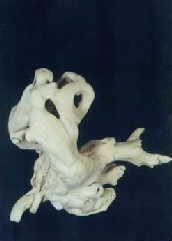Next comes the principle of expressing the mentality and sentiment of the creator. Root carving derives from real life, and it surpasses and regresses to it. However, it is by no means a replication of real life; rather, the creator reveals his inner feelings by making use of the characteristics of the natural root.

Fish beauty
Finally comes the principle of seeking singularity and pursuing beauty. No art form is detached from the material used, and root carving is no exception. Root artists have to refer to nature for materials and their pursuit of singularity and beauty lies in the process of selecting roots as well as in the conception process. They have to find out and collect roots of various odd shapes, which give them creative inspiration. Only after obtaining a uniquely shaped root can the artist apply his or her wisdom, imagination and originality to creative root carving.
Types
1. Applied root carving. Root carvings of this type have a practical utility as well as ornamental value. Some common examples include home accessories, such as chairs, stools, tea tables, sofas, screens, flower shelves, and some stationeries, including brush shelves, ink slabs, etc.
2. Ornamental root carving. This kind of carving is primarily for decoration purposes and accounts for a large proportion of root carvings. Based on their respective shapes, they can be further classified into many types, such as root carvings featuring characters, animals, flowers, etc.
3. Aesthetic root carving. This refers to root carvings that cannot be named easily; they are also called "nameless" root carvings.










